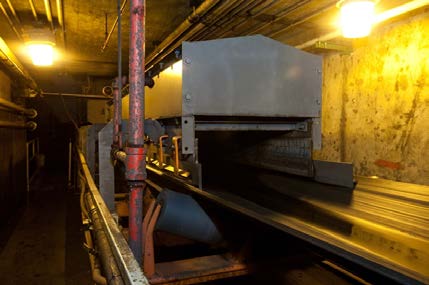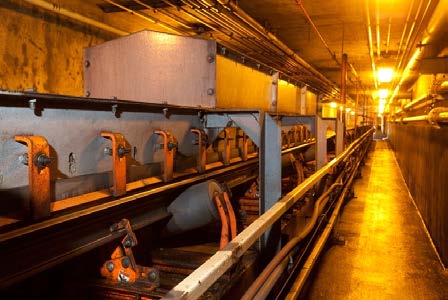Published: August 2nd 2016

Orlando Utilities Commission - Stanton Energy Center (SEC) is one of Central Florida’s leading environmental stewards, meeting or exceeding all air permit limits with advanced pollution control equipment while generating electricity to serve more than 342,000 residents.
The company follows a similar philosophy with respect to its working environment, cleaning the entire coal yard and all handling equipment every day. “Typically each day after we finish filling or bunkering the silos, the whole system is cleaned,” explained Material Handling Supervisor Stuart Cason. “That includes the yard, all the conveyors, chutes, floors, impact zones and rollers. In some places, it’s a wet washdown, while in others we sweep. It’s 7 days a week, every week of the year.”
Containing Fugitive Material
When company officials decided to upgrade the dust containment on one of its primary coal conveyors, they saw several potential benefits. There was the safety aspect: by limiting dust and spillage from one of its principal conveyors, engineers wanted to reduce airborne particles and eliminate a potential source of trips and falls. There was also the understanding that reducing cleanup would save maintenance time, allowing critical manpower to be deployed elsewhere and improving the staff’s efficiency. Further, preventing coal dust spillage would help minimize wear on rollers and other moving components, saving on replacement part costs and labor.
SEC started by looking at the areas which could benefit most from technology upgrades to the 36-inch conveyor, which travels at about 700 feet per minute. “We were looking for a better method of sealing the transfer zone, for starters,” explained SEC Plant Engineer Brian Moore. “We had skirt blocks and seals in place, but they were getting old, and some of them were leaking or repeatedly coming loose.”
“Coal dust is pretty abrasive, and when it got down into the impact rollers, idlers and troughers, it would pretty much eat them up,” remembered Cason. “We tried everything we could think of to improve the service life, but we were constantly replacing them.”
To address the situation, Martin Engineering supplied and installed a number of upgraded components, including Double ApronSeal™ Skirting, which employs two wear surfaces on a single elastomer sealing strip installed along the bottom of the skirtboard in the loading zone. When the bottom side of the sealing strip is worn, it can be inverted to deliver a second service life.
The skirtboard sealing system is installed on the sides of the loading zone to contain dust, eliminate spillage and reduce cleanup expenses. Believed to be the first dual-sealing system available, it incorporates a primary seal clamped to the steel skirtboard to keep lumps on the belt and a secondary or “outrigger” strip to capture any fines or dust particles that might pass beneath the primary seal. The secondary seal lies gently on the belt and self-adjusts to maintain consistent strip-to-belt pressure, despite high-speed material movement and fluctuations in the belt’s line of travel.
Martin Engineering technicians also installed an impact cradle to better absorb the force of the falling material and protect the belt and structure. The cradle stabilizes the belt’s line of travel to help prevent the escape of fugitive material. Its rugged impact bars are constructed of a top layer of low-friction UHMW resin and a lower layer of energy-absorbing SBR rubber. Each impact bar is reinforced with a bed of steel angles, and the wings can be adjusted to suit virtually any standard trough angle.
In addition, a Martin® Slider Cradle was added under the skirt board to better support the edges of the belt and eliminate sagging. The cradle helps prevent transfer point spillage by further stabilizing the belt path and facilitates effective sealing of the edges. Belt wear is minimized by eliminating pinch points where trapped material can gouge the belt surface.
To maintain precise centering in the loading zone, Martin Engineering technicians installed a belt tracking system for immediate, precise adjustment. Comprised of upper and lower components, the tracker works to reduce belt edge damage, prevent spillage and extend belt life. Designed to withstand the stress associated with wide, thick belts moving at high speeds, the tracker features heavy-duty construction that is well suited to heavy loads.

“We could see the improvement right away,” Cason continued. “It’s not just the savings in cleanup time, but also in preventing the idlers from wearing out prematurely. Now I don’t have to send my guys out there to replace those failed components, so it saves on labor and replacement parts, as well as the housekeeping time.”
The System Centerpiece
A key element in the material handling system upgrade was addressing the large, under-performing dust collector. “We wanted to upgrade our dust collection equipment, because we knew technology had advanced since ours was installed,” said Maintenance Supervisor Jon Janis. “Even when it was functioning properly, the old unit was a high-maintenance item,” he added.
The Martin Engineering team installed a high-efficiency insertable air cleaner with an explosion-proof motor. It’s an automatic, self-cleaning design that employs filter elements approximately one-eighth the size of conventional filter envelopes. The smaller filter elements allow a significant reduction in the dust collector’s space requirements, so it can be installed in locations where tight quarters complicate the placement of other systems.
The mesh-like material also filters better and lasts longer - while consuming less energy - than conventional filter bags. Further, the new filters allow a smaller size fan to move air through the elements, helping to reduce the overall power consumption of the collection system.
“The old unit had a large footprint, and it was too close to the emergency reclaim area,” added Cason. “A smaller, high-efficiency insertable unit gives us back that space and does a better job of filtering the air.”
The Martin Engineering design features a pulse cleaning system, which uses a short burst of air sent back through the filter to dislodge accumulated material. Filter changes are a no-tool procedure from the clean side of the dust collector.
“These new insertable air cleaners can eliminate many of the problems seen with central ‘baghouse’ collection systems, including long runs of ducting, large enclosures, difficult maintenance and high power consumption,” commented Martin Engineering Product Engineer Dan Marshall. “They help solve airborne dust problems by keeping fine particles in the load or returning them to the material stream.”
The new line of insertable units was developed to handle the heavy dust concentrations and air volumes arising from material transfer points. They are designed to remove 99.9% by weight of all dry particulates 0.5 micron and larger (based on a time-weighted average of a properly-installed, operated and maintained unit).
The automated “reverse jet” cleaning sequence facilitates continuous operation, keeping filters working effectively with a minimum of compressed air. The small integrated fan runs only when the conveyor is operational, further improving energy efficiency.
“These systems eliminate the need for installing or maintaining ductwork, and there’s no haulage or cleanup costs for waste disposal, since fugitive material is contained within the process,” Marshall added. “One of the most popular features with operators is the clean-side access for inspection and filter changeouts,” he said. “It’s a quick and easy process, saving further on time and maintenance costs.”

Also contributing to the air cleaner’s smaller footprint is a modified transfer chute, with modular hood-and-spoon components to better manage material flow, and a stilling zone to reduce turbulence. The engineered flow chute employs special geometries that capture and concentrate the material stream as it travels through the chute. Every design is tailored to suit the specific material characteristics and conveyor systems of the individual customer, rather than using stock products and attempting to make them work. Transfer chutes from Martin Engineering provide the dual benefits of minimizing aeration and preventing buildup within the chute, particularly important when dealing with combustible materials.
Asked to summarize the results of the upgrades, Stuart said, “For me, not having those clean-up and repair battles is a huge relief. And the whole area is a cleaner, safer working environment.”
Janis was unequivocal. “No question that the system has paid for itself. We used to spend a lot of time making adjustments and repairs, but since the install, the system has been essentially maintenance-free. It doesn’t matter what kind of coal we run, or whether the coal is damp from rain or completely dry. The fines are contained.”
Jon added that continued service excellence has helped to make OUC a repeat customer. “Manpower is at a premium right now, and every expenditure is closely scrutinized. Martin Engineering has proven its value repeatedly. They have advanced technology, but their approach is to provide application-specific solutions, not just try and sell us the latest product.”